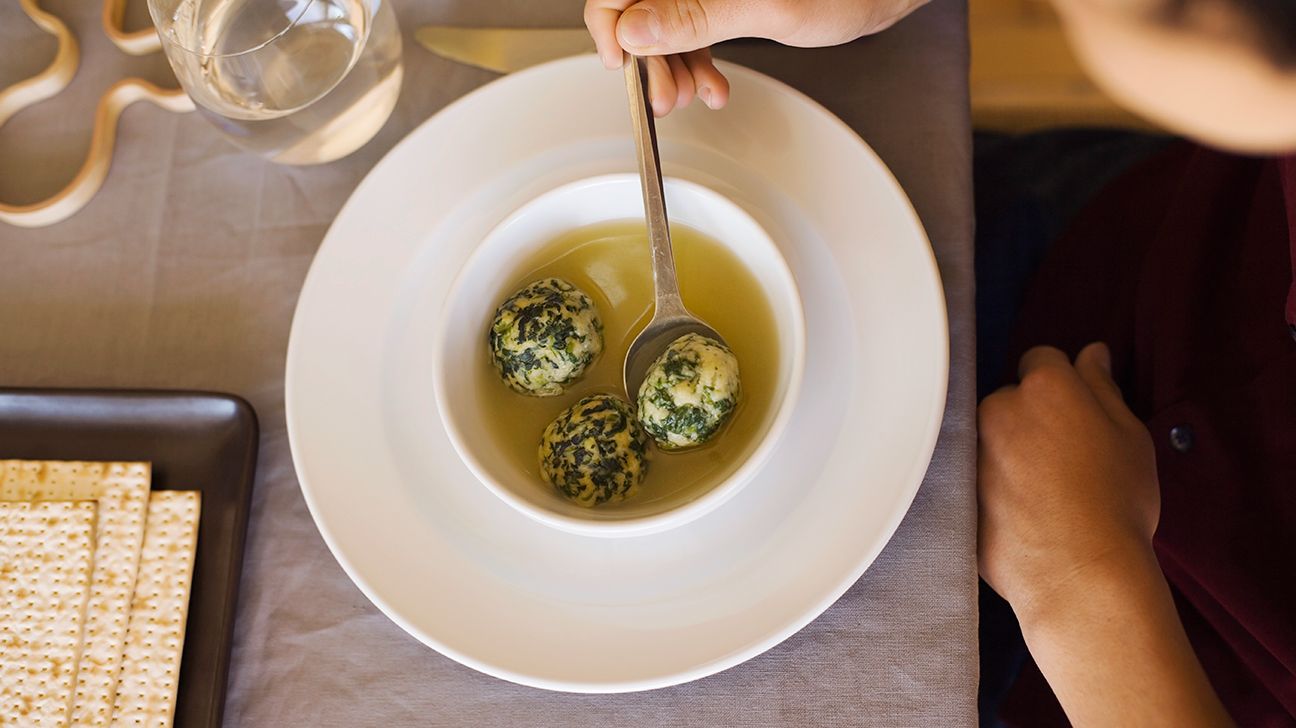Jewish people with diabetes may make changes to the food they eat and their care plan during holidays like Passover. Try lower-carb matzo, wine or grape juice with less sugar, and low calorie macaroons.

Passover is one of the most widely celebrated Jewish holidays, and it involves many different foods. For people with diabetes who celebrate and follow traditional practices, it may be challenging to know what that means for blood sugar and diabetes management.
This 8-day holiday often includes a number of symbolic Jewish foods and drinks that may be higher in fat or carbohydrates or contain sugar and sweetness that people with diabetes may be cautious about.
You can respect this sacred Jewish holiday while also being health conscious with some meal swaps and eating choices.
Traditional Jewish cuisine on Passover (or Seder)
Traditionally, the main meal includes:
- matzo, which is a type of flatbread that doesn’t have yeast or leaveningagent to help it rise during baking; think of it like a giant Saltine cracker without salt
- matzo ball soup
- haroseth, a mix of chopped apples, nuts, honey, cinnamon, and sometimes other chopped-up dried fruit like dates (also sometimes spelled haroset, charoset, or charoseth)
- hardboiled or roasted eggs
- gefilte fish, such as carp, whitefish, or pike
- beef brisket, lamb, chicken, duck or goose
- fermented vegetables, including parsley, carrots, and asparagus
- bitter herbs, such as horseradish
- potato kugel, which is a baked pudding with eggs, onions, fat, light starch, and potatoes or matzo meal
- rice, corn, and beans (allowed since 2015, after centuries of not being allowed)
- 4 glasses of red wine or sweet grape juice
- unleavened sponge cake, various cookies, and chocolate macaroons
- fruit compote (or fruit sauce)
Some Jewish people follow strict kosher guidelines year-round and during Passover, meaning there are additional dietary rules related to meats, dairy, fish, and eggs.
Raw fruits, vegetables, and any meat and fish that are already considered kosher are considered kosher for Passover. There are other restrictions and nuances for many other items.
The first night’s meal is known as Seder.
While the wine and food traditions differ depending on the family, region, and how they celebrate, many of the foods mentioned above are staples for Passover.
You may consider these substitutes
While matzo, potato kugel, and high fat soups may be on the traditional Jewish menu for Passover, some alternatives can work well for people with diabetes who follow a specific eating style.
The Jewish Diabetes Association provides a variety of alternatives:
- Matzo: Instead of using traditional packaged matzo or homemade matzo, you might consider lower-carb options, such as low carb nut or coconut flour. Some people may not eat the full amount of matzo because of the carbs, but it can depend on how closely they follow their traditions.
- Vegetables or any vegetable combination: Veggies are always a good option that may bring fewer carb and calorie concerns for those with diabetes.
- Eggs: You might consider using eggs in place of other ingredients that may be sweeter or more carb-heavy.
- Fruits: Many fruits are kosher and are considered acceptable during Passover. However, people with diabetes may need to monitor the type of fruit and the amount of carbohydrates in it to manage any blood sugar spikes.
The Joslin Diabetes Center and the Jewish Diabetes Association are both trusted sources for nutritional information related to Passover and traditional foods associated with Jewish culture. They also offer different choices and alternatives to some of those cuisine options.
Wine: Passover typically requires drinking 4 cups of wine. But given the sweetness and alcohol content, alternatives may include dry white wine that isn’t as sweet, grape juice, or watered-down wine. People with diabetes must also keep in mind how alcohol affects blood sugar and can lead to low blood sugar hours later.
Cookies and cakes: Passover tradition includes different desserts and sweets. Some may choose to make lower carb or lower sugar substitutes. For example, you might pass on the coconut macaroons and instead choose a dessert that’s lower in carbs (as long as it’s kosher or otherwise acceptable for Passover).
Managing hypoglycemia
Even during holidays, people with diabetes can experience low blood sugar. For those who observe Jewish holidays and restricted eating styles during those times of the year, this can present additional food-related challenges.
Options may include apple or grape juice, marshmallows, meringue cookies, and milk products. Glucose tablets are not approved for Passover because they are made with dextrose, which isn’t allowed.
Passover lasts for 8 days and certain aspects start after sunrise. These different eating routines can be challenging for people with diabetes.
It may mean adjusting diabetes medications or insulin doses to help prevent low blood sugar. Some people may also scatter Passover-safe foods or drinks throughout the day to help pad their blood sugar before later eating times.
It can take 4 hours before you get to the actual meal on Seder, and in the meantime, you may be snacking on carb-rich foods. For those using insulin and pump delivery devices in particular, this may be a time to consider a temporary dose or setting.
You can work with your diabetes care team, including a nutritionist or dietitian, to help understand your specific needs for Passover. They may suggest different diabetes management options, including adjusting your medications or insulin needs during this Jewish holiday.
Jewish people with diabetes may face challenges during Passover, in which many food and drink rules can be challenging to navigate based on their blood sugar effects.
You can try some alternatives to traditional foods and drink practices to be more diabetes-friendly.
Your healthcare team can help guide you on best practices and choices that may work for you based on your health and religious traditions.




